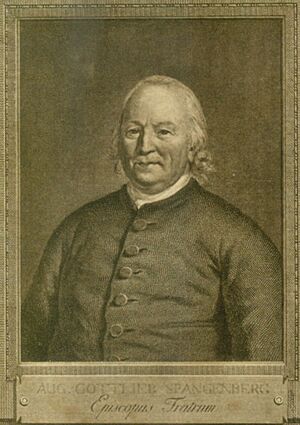August Gottlieb Spangenberg facts for kids
August Gottlieb Spangenberg (born July 15, 1704 – died September 18, 1792) was a German religious leader. He became a bishop in the Moravian Church. After Count Nicolaus Zinzendorf, Spangenberg helped the Moravian Church grow its missions around the world. He also made sure the church's beliefs and organization were strong in Germany.
Contents
Early Life and School
Spangenberg was born in Klettenberg, Germany. His father, Georg Spangenberg, was a pastor. When August was only thirteen, he lost both his parents. He went to a secondary school in Ilfeld.
In 1722, he started studying law at the University of Jena. A professor named J. F. Buddeus helped him get a scholarship. Soon, Spangenberg decided to study theology (the study of religious faith) instead of law. He finished his degree in 1726 and started giving free lessons on religious topics.
His Career and Work
Spangenberg was very active in a student group that helped poor children. They set up free schools and trained teachers. In 1728, he met Count Zinzendorf, who was a leader of the Moravian Church.
In 1730, Spangenberg visited the Moravian community in Herrnhut. He liked their way of life. He then started a group in Jena to help the sick and poor. However, the authorities saw this as a challenge and closed it down.
Meanwhile, his free lessons at Jena were very popular. He was offered a job as a professor at Halle. He accepted in 1732. But Spangenberg soon disagreed with the religious leaders in Halle. He felt their religious life was too formal. They also didn't like his different ideas about church life.
Things got difficult when Spangenberg joined private religious services and kept his connection with Count Zinzendorf. The university told him to change his ways or leave. The king got involved and ordered Spangenberg to be removed from Halle by soldiers in April 1733.
Spangenberg then went to Herrnhut. He found his true calling among the Moravians. For sixty years, he became their main religious thinker and leader. The Moravians called him "Brother Joseph." This was because, like Joseph in the Bible, he took care of his fellow church members.
Missions Around the World
For the first thirty years (1733-1762), Spangenberg focused on organizing Moravian missions. These missions were in places like Germany, England, Denmark, the Netherlands, and Suriname.
He also worked in Pennsylvania, in what was then British America. He tried to bring different religious groups into the Moravian faith. In 1741-1742, he traveled to England to raise money for his missions.
Later, as a bishop, Spangenberg oversaw the Moravian churches in Pennsylvania. He helped raise money to protect the colonies during the Seven Years' War, a big conflict. He also wrote to defend the Moravian Church against attacks from other groups. He helped make Zinzendorf's ideas more practical and simple. In 1761, Spangenberg visited Emmaus, Pennsylvania, a Moravian town. He announced its new name, Emmaus, saying it would be a place where their hearts would "flame."
Leading the German Moravian Church
The next thirty years of his work (1762-1792) were about strengthening the German Moravian Church. When Zinzendorf died in 1760, Spangenberg returned to Herrnhut. The Moravian Church needed his help to get organized.
In 1777, Spangenberg was asked to write a book called Idea Fidei Fratrum. This book explained the Christian beliefs of the Moravian Church. It became the official statement of their faith. Compared to Zinzendorf's writings, Spangenberg's book showed his balanced and moderate views.
The Idea Fidei Fratrum explained beliefs using words directly from the Bible. It didn't have much complex religious thinking. Spangenberg did make his views clear on some important topics. For example, he wrote about whether God wants everyone to be saved.
He wrote: "If we sum up that which hath been deduced from the Scripture concerning the Father, Son and Holy Ghost, we may answer the question, Whether God would have all men to be saved? with a confident, Yes. There is in him the most fervent desire, and the most earnest will that we all should be saved."
He used many Bible verses to support this idea. He also noted that Jesus suffered to save all people. Spangenberg believed that God wants everyone to turn away from sin and be saved.
In his final years, Spangenberg spent a lot of time on educating young people.
Death
August Gottlieb Spangenberg died in Berthelsdorf on September 18, 1792. He was buried in God's Acre in Herrnhut, Germany.
Works
- Idea fidei fratrum (Barby, 1782; translated into English as Exposition of Christian Doctrine, London, 1784)
- Declaration über die seither gegen uns ausgegangenen Beschuldigungen sonderlich die Person unseres Ordinarius (Zinzendorf) betreffend, a work defending Zinzendorf (Leipzig, 1751)
- Apologetische Schlußschrift, another work defending Zinzendorf (1752)
- Leben des Grafen Zinzendorf (3 volumes, Barby, 1772-1774; a shorter English version was published in London, 1838)
- Many hymns (religious songs).



